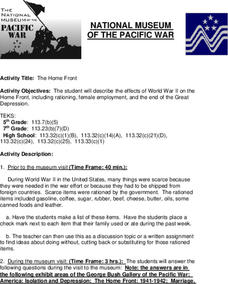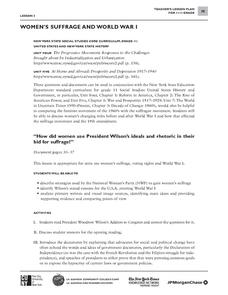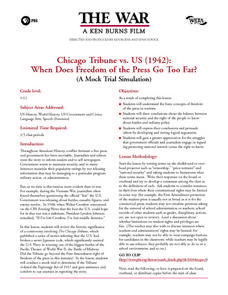Curated OER
Double V Campaign: Victory at Home and Victory Abroad
Students write a persuasive essay as if they were an African American in World War II and decide if they would contribute war bonds or not. In this World War II lesson plan, students study the segregation of World War II and the unity...
Curated OER
Diplomacy in the Inter-War Years (5)
In this online interactive world history worksheet, students answer 10 matching questions regarding the years between World Wars I and II. Students may submit their answers to be scored.
Curated OER
The Home Front
Students describe the effects of World War II on the Home Front, including rationing, female employment, and the end of the Great Depression. They interview someone who was at home during World War II and ask them how the war affected...
Curated OER
Where in the World War? Mapping WWII in the Pacific
Students study the geography of the Pacific theater of World War II. They study maps to examine the geography and features of the land.
Rutgers University
How the Allies Won World War II: Island-hopping in the Central Pacific
Using primary source documents, young historians explore the strategies the US used to defeat Japan during WWII. They also learn about the American military experience, and innovations that changed the style of warfare. Students benefit...
Constitutional Rights Foundation
Women in the Military
Scholars analyze the role of women in the military in United States history. Using group research, debate, and diary entries, they explore various military activity in America. To complete the lesson, young historians write an essay...
Annenberg Foundation
Postwar Tension and Triumph
Go get the American Dream lifestyle! The 19th lesson in a 22-part series exploring American history shows learners the post-WWII economic boom. Using primary sources, photographs, and cartoons, groups discuss their findings and present...
University of California
The Vietnam War (1945 – 1975)
Have you ever wanted to do something so perfectly you wound up not doing it well at all? Young historians use primary and secondary documents to analyze the United States involvement in the Vietnam War. The issues surrounding the...
DocsTeach
Baseball: A Morale Booster During Wartime?
How did baseball become America's national pastime? A sports-minded activity explores the importance government placed on baseball to boost morale during both world wars. Academics read letters to understand the importance of baseball...
Curated OER
The Allies Win the War
This PowerPoint clearly outlines many elements that contributed to the Allied Forces winning WWII. Topics covered are wartime technology, D-Day, The Holocaust, Perl Harbor, the Atomic Bomb and how winning the war changed the face of the...
City University of New York
Woman's Suffrage and World War I
How did women use President Wilson's ideals and rhetoric in their bid for suffrage? To answer this essential question, class groups analyze primary written documents and visual images.
Curated OER
WWII Website
Tenth graders research a topic related to World War II. They explore the causes and legacy of WWII, the European Theater of Operations, the Pacific Theater of Operations, Diversity in WWII, Women in WWII, and the Homefront. Students...
Curated OER
Navajo Code Talkers
Students investigate the Navajo Code Talkers and their role in World War II. They complete a Webquest, explore various websites, encode a short message, analyze maps, answer discussion questions, and read newspaper articles about secure...
Curated OER
Iwo Jima: Forgotten Valor
Students explore the nature of island combat on Iwo Jima during World War II. They examine the association between the Pacific Theater of World War II and Iwo Jima. Students evaluate Charles Lindberg's oral history, propaganda posters,...
Curated OER
Hitler¿¿¿s Fatal Gamble ? Comparing Totalitarianism and Democracy
Students compare/contrast totalitarianism and democracy and examine their roles in World War II. They read a handout, complete a Venn diagram, and participate in a class discussion.
Curated OER
Beauty Behind Barbed Wire
Pupils investigate the issue of racism against the Japanese during the start of World War II. They use the artwork of Estelle Ishigo to create context for the lesson and see how it provides a look into the life she experienced while...
Curated OER
World War I For the Soldier
Ninth graders examine the main events of World War I and identify the major points of the Treaty of Versailles. They read and discuss a scenario about boys fighting at school and create a treaty, read the poem "The Sentry" by Wilfred...
National WWII Museum
“My Dear Little Boys…” Interpreting a letter home from the war
Letters have long been prized by historians as primary sources for what they reveal not only about events but also about the emotional responses of the writers to these events. "My Dear Little Boys," a letter written by Leonard Isacks on...
Curated OER
Daniel's Story Study Guide
Students explore the concept of prejudice. In this World War II activity, students read Daniel's Story by Carol Matas. Students complete the provided study guide as they read the novel and discuss the Holocaust.
Curated OER
Japanese Internment Camps in the US During World War II
Eighth graders analyze the impact of the Japanese/American conflict during World War II on the Japanese American population and evaluate the consequences of government action regarding international conflict. Students demonstrate their...
Curated OER
New World, Old Evils: Latin America and the Holocaust
Students examine how Latin America was affected by the Holocaust in Europe. In groups, they research topics related to Latin America and World War II. They interview survivors if possible and discover how entire nations were effected...
Curated OER
On The Home Front
Students write their responses to five questions about their home town. After watching an excerpt from "The War", they work together in groups to identify the characteristics of the four towns in the movie into a graphic organizer. ...
Curated OER
Chicago Tribune vs. US (1942): When Does Freedom of the Press Go Too Far?
Students define freedom of the press in peace and war time. As a class, they identify the need for the public to be informed, but discuss where the line should be drawn to protect national security. They develop their arguments and...
Curated OER
Non-Violence Means "Doing Nothing"
Students reflect on violence and non-violence. In this World History lesson, students read an article by Gandhi then write an essay as to whether they agree or disagree with his thoughts. Students then share all their ideas...























